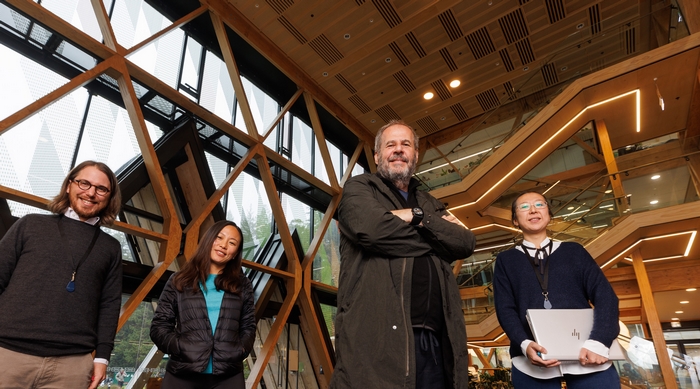Multi-award-winning architect heaps praise on Te Whare Nui o Tuteata
14 September 2022
Internationally renowned architect Mario Cucinella has visited Scion’s Te Whare Nui o Tuteata, highlighting the sense of protection and warmth it evokes.
Cucinella praised the timber design features and the sense of wellbeing manuhiri (visitors) enjoy when walking through the doors of the 3-storey timber structure.
“It’s a very welcoming building, in terms of the feeling it conveys,” he says. “The body recognises materials; you feel warmth, a sense of protection – you feel it in you. That’s the value of using wood.”
Cucinella made a special trip to Rotorua to visit Te Whare Nui o Tuteata after speaking at Te Kāhui Whaihanga New Zealand Institute of Architects’ conference in Auckland as a guest speaker.
Based in Bologna (Italy), some of his notable projects include eco-houses 3D-printed using clay, a hospital with 'smog eating' ceramic fins and an iconic Cross-laminated timber nursery school grounded in nature.
“Designing buildings which need few energy inputs in materials and operations is a pillar of sustainable architecture”, says Cucinella, who stresses the role architects have in influencing the construction of more environmentally friendly living and working spaces.
Te Whare Nui o Tuteata is the perfect illustration of a building that combines design excellence with sustainability features. Believed to be the world-first diagonal-grid timber structure for a three-storey building, it is embodied-carbon neutral. This is thanks to building’s extensive use of wood, with its timber structure alone storing about 418 tonnes of CO2-eq over the course of its life.
Cucinella says the building shows a strong synergy between the materials used and its architectural design.
“Often designers use engineered wood just as a structural material, not as a design material. Here, the design team has used a combination of materials for sustainability and structural needs without compromises on the architectural design quality.
“I know how much work will have gone into this building; the attention to details, the engineering solutions that architects and engineers delivered. The result may look simple, but I know there is a lot of complexity behind the design solutions that are tailored around wood. The behaviour of wood is not the same as the behaviour of metal or concrete and this design celebrates that.”
Timber construction is growing in Europe and internationally. Climate change risks are driving awareness and more widespread response to the need of reducing greenhouse gasses emissions. “This is impacting the design and construction sector,” Cucinella says.
“Governments in Europe are introducing more building regulations aimed at reducing emissions; that is influencing the direction of the market. The design and construction sector needs to respond and change the system of production. For designers, knowledge is very important, so more education is needed on low carbon building solutions, including materials.”
As a leader in the industry, Cucinella has already responded by founding the SOS – School of Sustainability, a programme for graduates and emerging professionals wanting to investigate sustainability and innovation themes in architecture through research and experimentation.
Cucinella believes education will drive more designers to adopt alternative construction materials, such as engineered-wood products.
“It is very hard to reach CO2 emission neutrality for your design if you don’t use wood. Young architects are much more aware of this challenge, and the need to tackle climate change and reduce our dependency on fossil fuels.
“They are curious to learn about how they can make a difference. There is hope with this generation of changemakers.”
Architectural design – RTA Studio, Irving Smith; Structural engineering - Dunning Thornton.

L-R: Andrea Stocchero, Lin Liu, Mario Cucinella, Marie Joo Le Guen
